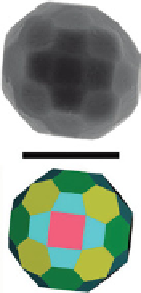Environmental Engineering Reference
In-Depth Information
(a)
(b)
(c)
(d)
(e)
111
100
311
110
figure 3.5
Typical FeSeM images of as-synthesized polyhedral 50-facet Cu
2
O microcrystals (a) and observed and simulated (bottom)
individual polyhedra with different polygons facing up (b)-(e). Scale bar: 2.0 µm. Reproduced by permission from Ref. [110]. © 2010,
American Chemical Society.
high-index {744} and {211} facets (Fig. 3.6) were first achieved in the process of systematic shape evolution. According to the
facile strategy, the morphologies of the products could be precisely tuned from cubic, 18-facet, and 26-facet polyhedrons exposing
low-index facets to the 50- and 74-facet polyhedrons exposing high indexes of {211}, {522}, and {744}, by simply altering the
NaOH concentration. Based on the control experiments, it was found that high NaOH concentration could promote crystal growth
along the [100] direction and increase the ratio (
R
) of the growth rates along the [100] and [111] directions, which caused the
shape evolution of the Cu
2
O polyhedrons with different index facets. Figure 3.7 shows the SeMic images and the corresponding
simulated structures of a series of Cu
2
O polyhedrons by changing the concentration of NaOH from 1.5 to 9.5 M in the aqueous
solution of CuSO
4
and ascorbic acid. Figures 3.7a and b shows the SeMic images of Cu
2
O cubes when the NaOH concentration
was set as 1.5 M. Figure 3.7c presents the corresponding simulated structure of the Cu
2
O cube with exposed {100} facets, which
are square facets. As the NaOH concentration increased to 2.5 M, the 18-facet polyhedron was obtained (Fig. 3.7d and e).
Compared with the Cu
2
O cube (Fig. 3.7c), the emerging new facets in the 18-facet Cu
2
O crystal are {110} facets hexagon facets,
which grow between any two adjacent {100} facets. The corresponding simulated {110} facets are hexagon facets, which are
shown in Figure 3.7f. When the NaOH concentration was elevated to 4 M, the 26-facet polyhedron evolved along with the {111}
facets (Fig. 3.7g and h). The {111} facets in Figure 3.7i are presented by triangles, grown among the relatively newer facets {110}
shown in Figure 3.7f. As the NaOH concentration reached 6.5 M, a 50-facet Cu
2
O crystal exposing {522} facets was formed
(Fig. 3.7j and k), and every four {522} facets, given by hexagons adjacent to squares facets, grows around every single (100) facet





